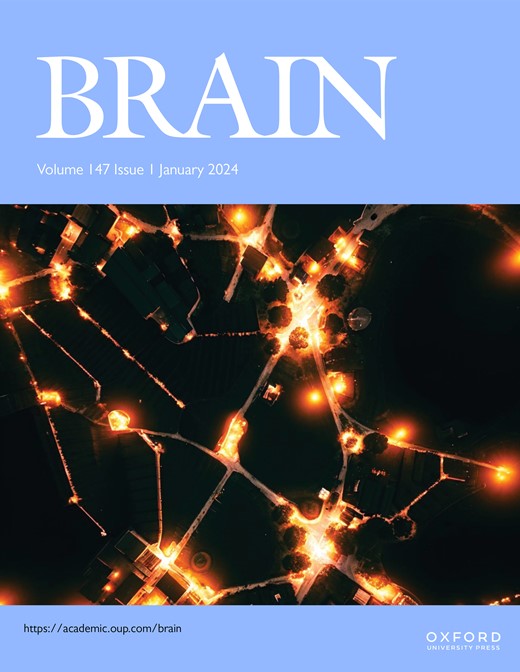The genetic and phenotypic spectrum of GABRB1-related disorders
IF 10.6
1区 医学
Q1 CLINICAL NEUROLOGY
引用次数: 0
Abstract
Pathogenic variants in GABAA receptor subunits genes (GABR*) are important contributors to rare and common genetic epilepsies. Here, we present a comprehensive analysis of variants in GABRB1, which encodes the GABAA receptor β1 subunit, by revealing their functional implications, establishing genotype-phenotype correlations, and evaluating treatment response. Clinical information on individuals carrying a GABRB1 variant was obtained through an international collaboration and literature review. Our cohort included 19 individuals (7 males, 12 females) from 15 families harboring 13 different GABRB1 variants (11 missense, 1 indel, 1 stop). Functional analysis was performed using two-electrode voltage-clamp recordings in Xenopus laevis oocytes. For all eleven missense variants, α1β1γ2 GABAA receptors with a single mutant β1 subunit were used. Four missense variants were selected for further functional analysis using α5β1γ2 GABAA receptors with two mutant β1 subunits. Gain-of-function (GoF) effects, characterised by increased GABA-sensitivity, were observed for eight missense variants. Loss-of-function (LoF) effects were observed for one, and no functional effects for two variants. Clinically, GoF variants were only observed in individuals with severe early-onset disease including profound intellectual disability, hypotonia, and early mortality. Additionally, cortical visual impairment, dysmorphisms and cortical atrophy were exclusive to this cohort. By integrating previously reported clinical data for variants in other GABR* genes we validated that these features were associated with GoF variants more broadly. The only LoF variant was identified in a nuclear family with the relatively milder syndrome of genetic epilepsy with febrile seizures plus. Seizures were therapy-resistant in all individuals with GoF variants, and in a single individual with a LoF variant. The GABAergic anti-seizure medication (ASM) vigabatrin caused life-threatening side-effects in two individuals with GoF variants, while the sodium-channel blocker (SCB) lamotrigine exacerbated seizures in a single individual carrying a LoF variant. By integrating data from literature on all GABR* variants, we observed a potential dichotomy in treatment responses: GABAergic and broad-spectrum ASMs, such as valproate and levetiracetam, were more effective for individuals with LoF variants in GABR* genes, while SCBs showed greater benefit for GoF variants. Additionally, there is an increased risk of adverse effects of SCBs in LoF and vigabatrin in GoF variants. Our results highlight the importance of functional characterisation of variants and clinical predictors in guiding treatment strategies for individuals with GABRB1 and other GABR* variants, though larger prospective studies are needed to confirm these observations.gabrb1相关疾病的遗传和表型谱
GABAA受体亚单位基因(GABR*)的致病变异是罕见和常见遗传性癫痫的重要因素。在这里,我们通过揭示其功能意义、建立基因型-表型相关性和评估治疗反应,对编码GABAA受体β1亚基的GABRB1变异进行了全面分析。通过国际合作和文献综述获得了携带GABRB1变异个体的临床信息。本研究包括来自15个家族的19名个体(7名男性,12名女性),其中包含13种不同的GABRB1变异(11种错义,1种indel, 1种终止)。采用双电极电压钳记录法对非洲爪蟾卵母细胞进行功能分析。对于所有11个错义变体,使用具有单个突变β1亚基的α1β1γ2 GABAA受体。利用α5β1γ2 GABAA受体和两个突变β1亚基,选择4个错义变体进行进一步的功能分析。以gaba敏感性增加为特征的功能获得效应(GoF)效应在8种错义变异中被观察到。其中一种变体观察到功能丧失(LoF)效应,而两种变体没有功能效应。在临床上,GoF变异仅在患有严重早发性疾病的个体中观察到,包括深度智力残疾、张力低下和早期死亡。此外,皮质视觉障碍、畸形和皮质萎缩是该队列所独有的。通过整合先前报道的其他GABR*基因变异的临床数据,我们证实这些特征与GoF变异有更广泛的关联。唯一的LoF变异是在一个具有相对温和的遗传性癫痫综合征加上热性癫痫发作的核心家庭中发现的。所有GoF变异个体和单个LoF变异个体的癫痫发作均具有治疗抵抗性。GABAergic抗癫痫药物(ASM) vigabatrin对两名GoF变异患者造成了危及生命的副作用,而钠通道阻滞剂(SCB)拉莫三嗪加重了一名LoF变异患者的癫痫发作。通过整合所有GABR*变异的文献数据,我们观察到治疗反应的潜在两极分化:GABR*能和广谱asm,如丙戊酸盐和左乙曲西坦,对GABR*基因LoF变异的个体更有效,而scb对GoF变异的个体更有效。此外,LoF的SCBs和GoF变体的vigabatrin的不良反应风险增加。我们的研究结果强调了变异的功能特征和临床预测因素在指导GABRB1和其他GABR*变异个体的治疗策略中的重要性,尽管需要更大规模的前瞻性研究来证实这些观察结果。
本文章由计算机程序翻译,如有差异,请以英文原文为准。
求助全文
约1分钟内获得全文
求助全文
来源期刊

Brain
医学-临床神经学
CiteScore
20.30
自引率
4.10%
发文量
458
审稿时长
3-6 weeks
期刊介绍:
Brain, a journal focused on clinical neurology and translational neuroscience, has been publishing landmark papers since 1878. The journal aims to expand its scope by including studies that shed light on disease mechanisms and conducting innovative clinical trials for brain disorders. With a wide range of topics covered, the Editorial Board represents the international readership and diverse coverage of the journal. Accepted articles are promptly posted online, typically within a few weeks of acceptance. As of 2022, Brain holds an impressive impact factor of 14.5, according to the Journal Citation Reports.
 求助内容:
求助内容: 应助结果提醒方式:
应助结果提醒方式:


